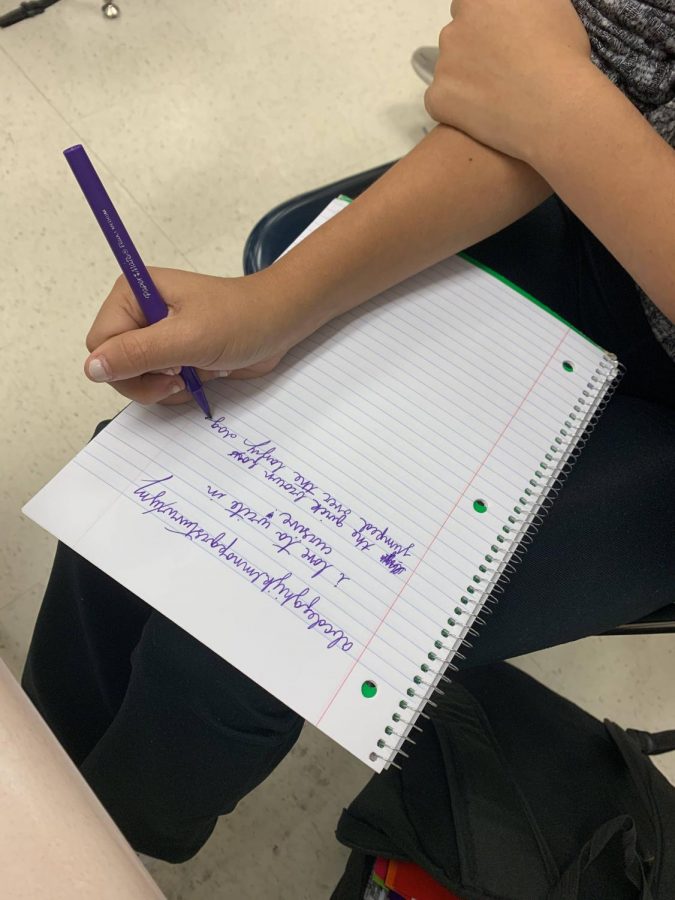Writing out traditions of cursive for the future
Students in the U. S. learn cursive in their primary school, but rarely use it after. Teaching cursive is an outdated practice that has been replaced by technology.
October 21, 2019
All of us remember the infamous kindergarten worksheets where students are asked to trace along a dotted line or continuously pencil out ten curly versions of the letter “Q” in a row to learn the cursive alphabet. What do not remember? Ever using it again.
For many years, there have been ongoing debates on whether or not to teach elementary school students how to write in cursive. Many parents have continued to fight for the writing style to remain in the lesson plan, claiming that it is a cultural tradition that should not be lost in the generations to come. But when students will never be asked to write in cursive throughout the rest of their entire educational career past the age of seven, it is only a monumental waste of valuable student and classroom time.
Kindergarten classrooms are where many of the basics are taught to students- the foundations of math, reading and writing- things that will set up and determine their academic performance in nearly all aspects of their future schooling. This time in student education is the time when they are the most malleable. Their understanding of the simple skills that are taught will be crucial to their development. Yet, time that could be spent on going over important universal rules of addition, spelling and grammar is rationed to make room for the task of learning a second way of writing the alphabet.
What they do not tell you in kindergarten is that this second alphabet will rarely, if ever, be useful. Even students in the highest points in their educational career at the most esteemed universities are never, and will never be given an assignment where their teacher requires a paper to be written in cursive. In fact, handwritten assignments are expected to be in print. The one and only time that cursive may serve a tangible purpose anywhere in adult life is when formulating a signature to sign checks.
Not only this, increasing technological advancements mean that most written assignments are required to be typed in a uniform font, size and format anyways. While teaching cursive may carry traditional values, class time allotted instead to typing lessons would teach the future.
However unconventional this way of writing may seem, the shift to typing needs to be accepted. No matter how nostalgic parents and educators may feel, the decreasing need for cursive is inevitable.
The gradual extinction of cursive is already starting to become a reality as a national survey of 612 elementary schools in the U.S. conducted by Really Good Stuff in 2013 reported that 41 percent of elementary schools were no longer incorporating cursive writing instruction in their classrooms.
Since 2010, 45 U.S. states have adopted and implemented the Common Core State Standards- an education initiative that does not contain any requirements that cursive lessons be taught to students.
Despite this downward spiraling trend, many protest that cursive teaches students hand-eye coordination and is a faster way to write than print is. They also rally behind the notion that students who are not taught cursive will consequently not be able to read older cursive documents and will therefore be “cursively illiterate.”
However, there are much better ways to increase hand-eye coordination than writing in cursive– this is exactly what physical education is for. Even so, when students barely even use cursive beyond the limited school lessons, this correlation really won’t make much of a difference. Additionally, many studies conducted to determine which writing style is the fastest have been ultimately inconclusive. What is not inconclusive is the fact that typing will always be faster than either one. While getting rid of lessons that teach students cursive may make them “cursively illiterate,” the absence of cursive readings in future academia means that students do not really have to be “cursively literate” at all in the first place.
While cursive may be a source of sentimentality for many adults, it is something that is simply not necessary in modern education. Students that believe otherwise can learn the style of handwriting on their own individual time in a setting that does not take time away from important and vital instruction. It is time for schools to come to terms with the assertion that cursive has clearly become a thing of the past.


